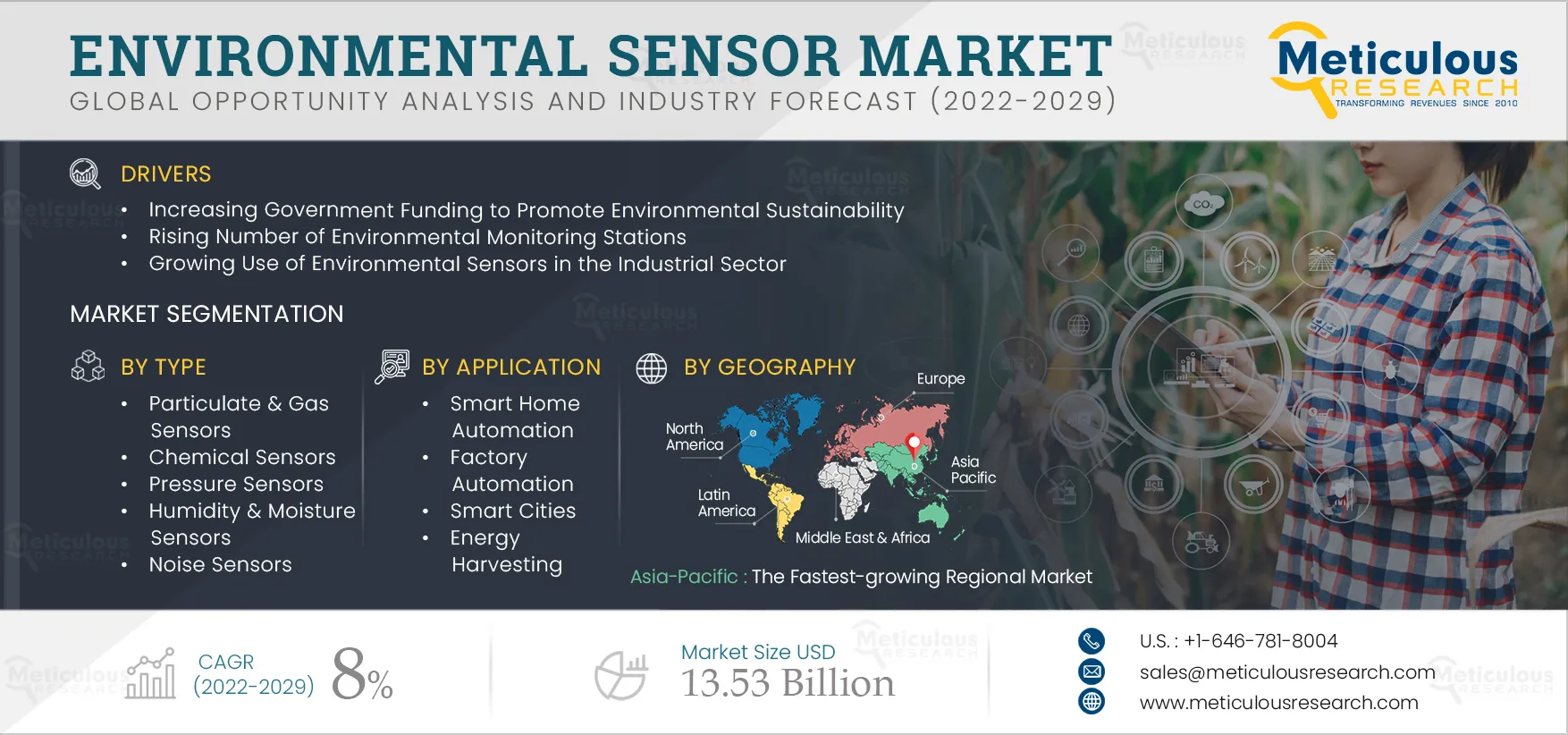The Environmental Sensor Market is projected to reach $13.53 billion by 2029, at a CAGR of 8% from 2022 to 2029. The growth of the environmental sensors market is driven by the increasing government funding to promote environmental sustainability, the rising number of environmental monitoring stations, and the growing use of environmental sensors in the industrial sector. Furthermore, the growing use of IoT and nanotechnology in environmental sensors and the rising need for air quality monitoring sensors are expected to create growth opportunities for the players operating in this market.
Here are the top 10 companies operating in Environmental Sensor Market
Founded in 1847 and headquartered in Munich, Germany, Siemens AG is a technology company that caters to the industrial, infrastructure, transport, and healthcare sectors. The company is active globally and provides automation and digitalization in the process and manufacturing industries, intelligent infrastructure for buildings and distributed energy systems, smart mobility solutions for rail & road, and medical technology & digital healthcare services. The company operates through three business segments: Digital Industry, Smart Infrastructure, and Other Revenue. The company’s environmental sensor portfolio comprises air quality sensors, temperature sensors, humidity sensors, and pressure and flow sensors.
Infineon Technologies AG (Germany)
Founded in 1999 and headquartered in Neubiberg, Germany, Infineon Technologies AG is a global leader in semiconductor solutions. The company offers microcontrollers, LED drivers, sensors and automotive & power management ICs. The company operates through five business segments: Automotive, Industrial Power Control, Power & Sensor Systems, Connected Secure Systems, and Other Operating Segments. The company offers environmental sensors through its Power & Sensor Systems segment.
Honeywell International Inc. (U.S.)
Founded in 1906 and headquartered in North Carolina, U.S., Honeywell International Inc. is a technology company that manufactures aerospace & automotive products; residential, commercial, and industrial control systems; specialty chemicals & plastics; and engineered materials. The company operates through four business segments: Aerospace, Honeywell Building Technologies, Performance Materials and Technologies, and Safety and Productivity Solutions. The company’s environmental sensor portfolio comprises air quality sensors, humidity sensors, temperature sensors, and water sensors.
Sensirion Holding AG (Switzerland)
Founded in 1998 and headquartered in Stäfa, Switzerland, Sensirion Holding AG is a supplier of environmental sensors. The company provides data on key environmental parameters such as humidity, temperature, carbon dioxide (CO₂), particulate matter and volatile organic compounds (VOCs). The company operates through four business segments: Automotive, Medical, Industrial, and Consumer. Through its subsidiaries and a strong distribution network, the company has a geographical presence across the Americas, EMEA, and APAC.
TE Connectivity Ltd. (Switzerland)
Founded in 2000 and headquartered in Schaffhausen, Switzerland, TE Connectivity Ltd. is a technology company that designs and manufactures connectors and sensors for several industries. The company provides a broad range of environmental sensors for transportation, industrial, healthcare, energy, data communications, and residential applications. The company operates through three business segments: Transportation Solutions, Industrial Solutions, and Communications Solutions. The company’s environmental sensor portfolio comprises humidity sensors, temperature sensors, pressure sensors, water level sensors, and airflow sensors.
Texas Instruments Incorporated (U.S.)
Founded in 1930 and headquartered in Texas, U.S., Texas Instruments Incorporated is a global semiconductor company that designs and manufactures analog and embedded processing chips for markets such as industrial, automotive, personal electronics, communications equipment, and enterprise systems. The company operates through three business segments: Analog, Embedded Processing, and Other. The company offers environmental sensors through its Analog segment. The company’s environmental sensor portfolio comprises humidity sensors and temperature sensors.
Renesas Electronics Corporation (Japan)
Founded in 2002 and headquartered in Tokyo, Japan, Renesas Electronics Corporation is a global leader in microcontrollers, analog, power, and SoC products. The company provides comprehensive environmental solutions for various automotive, industrial, infrastructure, and IoT applications. The company operates through three business segments: Automotive, Industrial/Infrastructure/IoT, and Other. The company’s environmental sensor portfolio comprises analog gas sensors, digital gas sensors, humidity sensors, and temperature sensors.
Emerson Electric Co. (U.S.)
Founded in 1890 and headquartered in Missouri, U.S., Emerson Electric Co. is engaged in the designing and manufacturing of automation products and delivering services for industrial, commercial, and consumer markets. The company operates through two business segments: Automation Solutions and Commercial & Residential Solutions. The company offers environmental sensors through its Automation Solutions segment. Through its subsidiaries and a strong distribution network, the company has a geographic presence across the Americas, Europe, Asia, and the Middle East & Africa.
Schneider Electric SE (France)
Founded in 1836 and headquartered in Rueil-Malmaison, France, Schneider Electric SE is engaged in manufacturing energy management systems and automation solutions. The company operates through two business segments, namely Energy Management and Industrial Automation. The company’s environmental sensor portfolio comprises temperature sensors, humidity sensors, air quality sensors, and pressure sensors. Through its subsidiaries and a strong distribution network, the company has a geographic presence across Western Europe, Asia-Pacific, North America, and other countries.
AVTECH Software, Inc. (U.S.)
Founded in 1988 and headquartered in Warren, U.S., AVTECH Software, Inc. is a leading manufacturer of proactive environment monitoring products for critical facilities and assets. The company develops room alert products that monitor temperature, humidity, power, flood/water leakage, smoke/fire, air flow, room entry, motion, and cameras in computer rooms, data centers, and other facilities. The company has a geographic presence across the U.S. and Ireland.
























